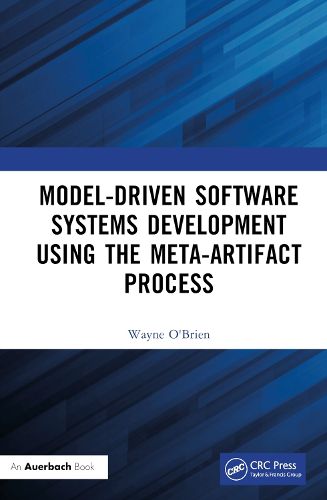Readings Newsletter
Become a Readings Member to make your shopping experience even easier.
Sign in or sign up for free!
You’re not far away from qualifying for FREE standard shipping within Australia
You’ve qualified for FREE standard shipping within Australia
The cart is loading…






The importance of architecture for software systems is widely accepted, but the role of architecture in the overall development process is not so clear. Presenting an architecture-centric process, Model-Driven Software Systems Development Using the Meta-Artifact Process makes the role of architecture clear. At its core, this book is about developing software systems and, more specifically, software code. It describes three major innovations for making software, which are combined with five widely used enabling technologies, to provide a complete, hypothesis-driven software development process known as Meta-Artifact Process (MAP). Having complete requirements is essential for making good software and supports the hypothesis-driven MAP.
MAP offers properties, qualities, and capabilities that help stakeholders and developers understand and reason about a domain and target systems of interest. MAP, through the central role of the Meta-Artifact and incorporating the view that a computer program is a hypothesis about the requirements, offers new ways to look at systems and their development, even changing the roles of developers and stakeholders.
Recommending agile methods wherever appropriate while supporting the OMG Essence standard and working within an overarching architecture, MAP presents ways to ensure that the requirements are complete and correct. It helps to identify likely points during development to form alternative hypotheses about them. Because MAP requires an underlying software development process, it can provide that clarity to existing processes in which the organization's developers are already proficient.
This book provides concrete examples from two broad but diverse areas-Accounting Information Systems in the commercial area and a military command and control system-to show the wide applicability of MAP in both commercial and defense domains.
$9.00 standard shipping within Australia
FREE standard shipping within Australia for orders over $100.00
Express & International shipping calculated at checkout
The importance of architecture for software systems is widely accepted, but the role of architecture in the overall development process is not so clear. Presenting an architecture-centric process, Model-Driven Software Systems Development Using the Meta-Artifact Process makes the role of architecture clear. At its core, this book is about developing software systems and, more specifically, software code. It describes three major innovations for making software, which are combined with five widely used enabling technologies, to provide a complete, hypothesis-driven software development process known as Meta-Artifact Process (MAP). Having complete requirements is essential for making good software and supports the hypothesis-driven MAP.
MAP offers properties, qualities, and capabilities that help stakeholders and developers understand and reason about a domain and target systems of interest. MAP, through the central role of the Meta-Artifact and incorporating the view that a computer program is a hypothesis about the requirements, offers new ways to look at systems and their development, even changing the roles of developers and stakeholders.
Recommending agile methods wherever appropriate while supporting the OMG Essence standard and working within an overarching architecture, MAP presents ways to ensure that the requirements are complete and correct. It helps to identify likely points during development to form alternative hypotheses about them. Because MAP requires an underlying software development process, it can provide that clarity to existing processes in which the organization's developers are already proficient.
This book provides concrete examples from two broad but diverse areas-Accounting Information Systems in the commercial area and a military command and control system-to show the wide applicability of MAP in both commercial and defense domains.